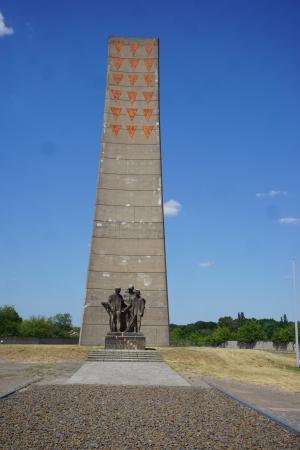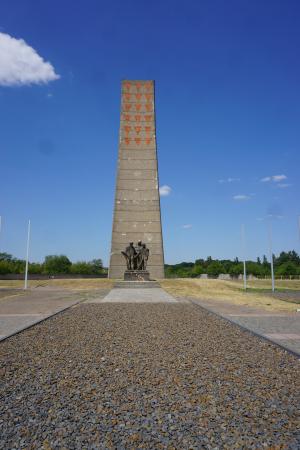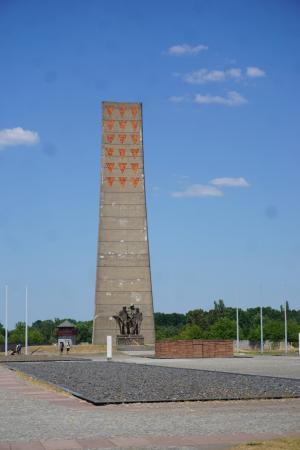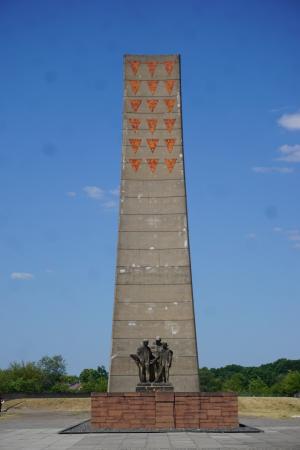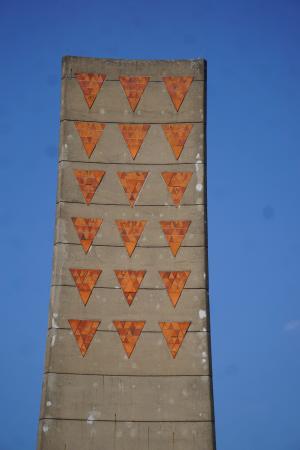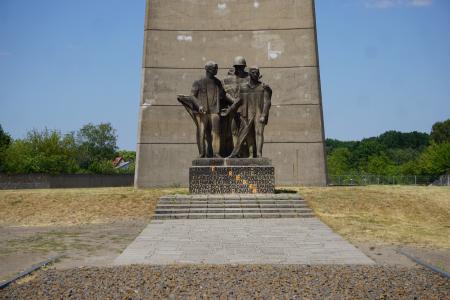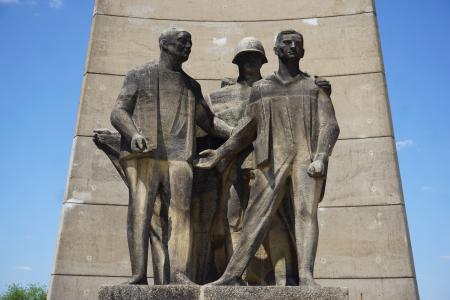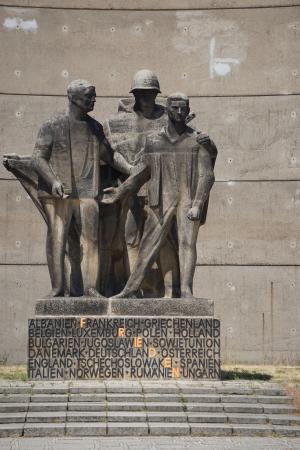Obj. ID: 51417
Memorials 'Liberation' Holocaust Memorial at Sachsenhausen Concentration Camp in Oranienburg, Germany
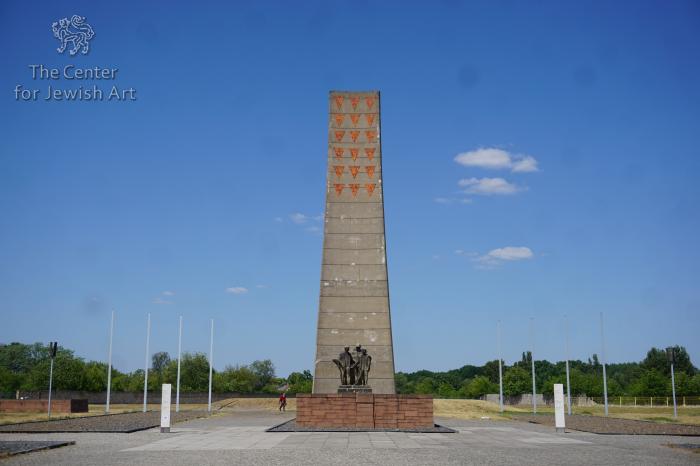
Memorial Name
Liberation
Who is Commemorated?
Soviet liberators of Sachsenhauen and political prisoners
Description
The monument is a forty-meter column with a triangular plan, that towers over a large open space. A pattern of eighteen red triangles adorns the top, representing political prisoners in the nazi concentration camp system. At the base of the tower is a large stone depicting a Soviet soldier with his arms extended around two male concentration camp survivors. A paved path leads from a stone rostrum and connects with the statue up five low stone steps.
On the front of the statue's base, the names of 20 countries of origin of camp inmates are inscribed in large block letters. Certain letters are highlighted in red to spell the work Frieden (peace). It is unknown whether this was intended or is a recent artistic intervention.
Inscriptions
German
Albien Frankreich Griechenland
Belgien Luxemburg Polen Holland
Bulgarien Jugoslawien Sowjetunion
D'a'nemark Deutschland Osterreich
England Tschechoslowakei Spanien
Italien Norwegen Rumanien Ungarn
Translation: Albia France Greece Belgium Luxembourg Poland Holland Bulgaria Yugoslavia Soviet Union Denmark Germany Austria England Czechoslovakia Spain Italy Norway Romania Hungary
Commissioned by
The Central Committee of the SED [Socialist Unity Party of Germany, the ruling party in East Germany]
sub-set tree:
Concrete
First commemorations
Commemoration of the victims of Sachsenhausen at the camp itself was not possible while the complex was used by the occupying Soviet army. The first commemorative events in the post-war period were held in the town center of nearby Oranienburg. When the Barracked People’s Police (KVP) took over the site in 1950, historic building structures began to be neglected and destroyed. It was not until 1956, when foreign concentration camp survivors wanted to visit the site, that the area of the inmate camp was opened to visitors. At that time former camp internees persuaded the Central Committee of the SED [Socialist Unity Party of Germany, the ruling party in East Germany], to create three national memorial sites: Buchenwald, Ravensbrück, and Sachsenhausen.
Former Communist inmates wanted to include the whole of the Sachsenhausen concentration camp complex including the SS buildings, but a board of trustees appointed by the SED reduced the memorial to only the triangle of the protective custody camp. The topography of the inmate camp was then utterly changed by the removal of original buildings and the redesign of the site with new elements. According to Camp historians, “the “Geometry of Total Terror” [was] replaced by the “Triumph of Anti-Fascism”, culminating in a 40-meter high obelisk with red triangles around the top.
The following text is from https://www.sachsenhausen-sbg.de/en/history/1961-1990-sachsenhausen-national-memorial/:
‘Museum of the Anti-Fascist Struggle for Freedom by the Peoples of Europe’
Foreign former inmates’ associations created the ‘Museum of the Anti-Fascist Struggle for Freedom by the Peoples of Europe’ in a new building outside the former protective custody camp. In nineteen sections organized by country, the exhibition was mainly devoted to the war and resistance to Nazi Germany, with the Soviet Union and Germany each being given twice as much space as any others.
‘Museum of the Resistance Struggle and the Sufferings of Jewish Citizens’
It was only in response to protests by the Union of Anti-Fascist Resistance Fighters of Israel that the East German government had the Museum of the Resistance Struggle and the Sufferings of Jewish Citizens set up shortly before the inauguration of the Memorial, in Barracks 38 and 39, which were reconstructed from original parts, in the area of the ‘small camp’. Visitors were given very little information about the specific situation of Jewish inmates in Sachsenhausen; as was also mostly the case in West German memorials, no mention at all was made of Sinti and Roma, homosexuals, Jehovah’s Witnesses and other non-political groups of prisoners.
Inauguration
“The Sachsenhausen National Memorial was inaugurated on 23 April 1961 before 100,000 people. At this time, the Eichmann trial was taking place in Israel and a growing number of people were fleeing East Germany. The Wall was built just a few months later. The East German leadership used the inauguration of the Memorial to demonstrate its anti-fascist state doctrine both to its domestic audience and abroad. West German media took very little notice of the inauguration or else relativised the numbers of those who died in the concentration camp with the numbers of victims of the Soviet Special Camp, the existence of which was completely covered up in the Memorial.”
Farmer, Sarah. “Symbols That Face Two Ways: Commemorating the Victims of Nazism and Stalinism at Buchenwald and Sachsenhausen,” Representations 49 (1995): 115.
Fox, Thomas C., Stated Memory: East Germany and the Holocaust (Rochester, NY: Camden House, 1999).
Jacobs, Janet, “Memorializing the Sacred: Kristallnacht in German National Memory,” Journal for the Scientific Study of Religion 47, no. 3 (2008): 485–498
Marcuse, Harold. “The Afterlife of the Camps,” in Concentration Camps in Nazi Germany: The New Histories, ed. Jane Caplan and Nikolaus Wachsmann (New York: Routledge, 2010), 201– 202.
Sprigge, Martha. “Concentration Camp Memorials,” in Socialist Laments: Musical Mourning in the German Democratic Republic. Oxford Academic, 2021, 192-250
“Biography René Graetz,” artshaw.com, http://www.artshaw.com/artgraetz%20seiten/englisch/texte/biografie%20rg_eng.html (accessed August 20, 2023)





